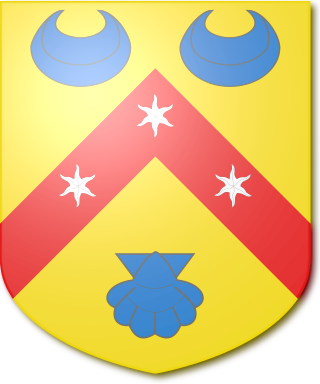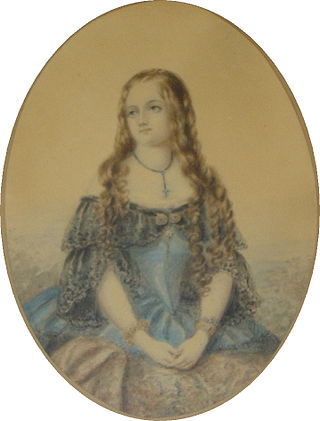The Duffbaronetcy, of Halkin in the County of Aberdeen, is a title in the Baronetage of the United Kingdom. It was created on 12 November 1813 for James Duff, British Consul in Cádiz, with remainder to his nephew, William Gordon.

The Alexander, later Cable-Alexander Baronetcy, of the City of Dublin, is a title in the Baronetage of the United Kingdom. It was created on 11 December 1809 for William Alexander, Lord Mayor of Dublin. The second Baronet was a Director of the Bank of Ireland. The third Baronet was Attorney-General to Albert Edward, Prince of Wales, later Edward VII. The seventh Baronet assumed in 1931 by deed poll the additional surname of Cable. As of 31 December 2013 the present Baronet has not successfully proven his succession and is therefore not on the Official Roll of the Baronetage, with the baronetcy considered dormant.

The Henniker Baronetcy, of Newton Hall in the County of Essex, was created in the Baronetage of the United Kingdom on 2 November 1813 for Brydges Henniker, who had earlier represented Kildare Borough in the last Irish Parliament. He was the youngest son of John Henniker, 1st Baron Henniker. The sixth baronet was an admiral in the Royal Navy and sat as Conservative member of parliament for Galloway. The eighth Baronet was a brigadier in the Royal Engineers.

The Ogle baronetcy, of Worthy, was a title in the Baronetage of the United Kingdom. It was created on 12 March 1816 for Admiral Chaloner Ogle, of Kings Worthy, Hampshire.

The Lockhart, later Lockhart-Ross Baronetcy, of Carstairs in the County of Lanark, was a title in the Baronetage of Nova Scotia.

The Pocock Baronetcy, of Hart in the County Palatine of Durham and of Twickenham in the County of Middlesex, was a title in the Baronetage of the United Kingdom. It was created on 18 August 1821 for George Pocock, Member of Parliament for Bridgwater. He was the son of Admiral Sir George Pocock. The title became extinct on the death of the 4th Baronet in 1921.
The Steuart, later Seton-Steuart Baronetcy, of Allanton in the County of Lanark, was a title in the Baronetage of the United Kingdom. It was created on 22 May 1815 for Henry Steuart with special remainder to his son-in-law Reginald Macdonald. The second Baronet assumed the additional surname of Seton. The title became extinct on the death of the fifth Baronet in 1930.
The Kerrison Baronetcy, of Hoxne and Brome in the County of Suffolk, was a title in the Baronetage of the United Kingdom. It was created on 8 August 1821 for the soldier and politician Edward Kerrison who served in the Peninsular War and commanded the 7th Light Dragoons at the Battle of Waterloo. He was succeeded by his son, the second Baronet who sat as member of parliament for Eye. The title became extinct on his death in 1886.

The Denys, later Denys-Burton, later Denys Baronetcy, of Stratford Place in the County of Middlesex, was a title in the Baronetage of the United Kingdom. It was created on 23 November 1813 for George Denys, Member of Parliament for Kingston upon Hull. The second Baronet was a Deputy Lieutenant for the North Riding of Yorkshire. The third Baronet assumed the additional surname of Burton. The fourth Baronet used the surname Denys only. The title became extinct on his death in 1960.
The Domville Baronetcy, of St Alban's in the County of Hertford, was a title in the Baronetage of the United Kingdom. It was created on 28 July 1814 for William Domville, Lord Mayor of London from 1813 to 1814. He was a descendant of William Domville, elder brother of Gilbert Domvile, ancestor of the Domvile baronets of Tempoleogue. The title became extinct on the death of the seventh Baronet in 1981.
Alexander Macdonald Lockhart was a British Conservative politician and landowner.

The Scott baronetcy, of Lytchet Minster in the County of Dorset, was created in the Baronetage of the United Kingdom on 8 September 1821 for Claude Scott. The title became extinct on the death of the seventh Baronet in 1961.

The Campbell baronetcy, of Auchinbreck in the County of Argyll, was created in the Baronetage of Nova Scotia on 24 January 1628 for Sir Dugald Campbell. He was a descendant of Duncan Campbell of Kilmichael, younger son of Duncan Campbell, 1st Lord Campbell, ancestor of the Dukes of Argyll. The fifth Baronet was one of the Scottish representatives to the 1st Parliament of Great Britain.

The Shaw baronetcy, of Bushy Park in the County of Dublin, was created in the Baronetage of the United Kingdom on 17 August 1821 for the Tory politician Robert Shaw. The 3rd Baronet was also a politician.

The Smith baronetcy of Long Ashton, Somerset was created on 27 January 1763 for Jarrit Smyth, in the Baronetage of Great Britain. He was an attorney in Bristol, landowner and member of the Steadfast Society; and was Member of Parliament for Bristol from 1756 to 1768. The 1st Baronet was succeeded by his son and subsequently by two nephews.

The Cockerell, later Rushout baronetcy, of Sezincote in the County of Gloucester, was created in the Baronetage of the United Kingdom on 25 September 1809 for the nabob and politician Charles Cockerell. He was Member of Parliament for Tregony, Lostwithiel, Bletchingley, Seaford and Evesham. The family seat was Sezincote House, near Moreton-in-Marsh. Gloucestershire. The house was designed by Samuel Pepys Cockerell, brother of the 1st Baronet.
The Mackenzie baronetcy, of Kilcoy in the County of Ross, was created in the Baronetage of the United Kingdom on 15 March 1836 for Colin Mackenzie. He was a descendant of Alexander Mackenzie, son of Sir Colin "Cam" Mackenzie. The 2nd Baronet spent the years 1840 to 1846 in Australia. The title became extinct on his death in 1883.

The King baronetcy, of Charlestown in the County of Roscommon, was created in the Baronetage of the United Kingdom on 1 July 1815 for Gilbert King, son of Gilbert King (1710–1788), Member of the Irish Parliament for Jamestown, and a direct descendant of Edward King, Bishop of Elphin.

The Forbes baronetcy, of Newe in the County of Aberdeen, was created in the Baronetage of the United Kingdom on 4 November 1823 for Charles Forbes, a merchant in Bombay, India. He was a Member of Parliament for Beverley and then Malmesbury.
The Baillie baronetcy, of Polkemmet in the County of Linlithgow, was created in the Baronetage of the United Kingdom on 14 November 1823 for William Baillie. He was the son of William Baillie, Lord Polkemmet, a Lord of Session. The family seat was Polkemmet House near Whitburn, West Lothian.













